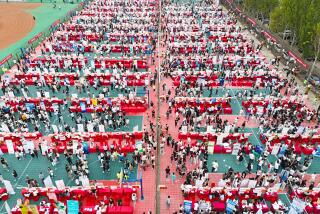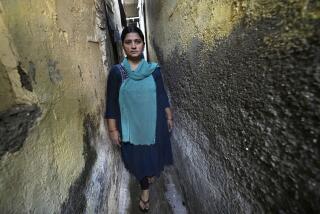Most Women Work Outside the Home but Find It’s Still a Man’s World
- Share via
GENEVA — Whether in offices, factories or down on the farm, in industrial powers or poor agrarian nations, most women work outside the home.
They find that it is still a man’s world.
Be they New York executives, computer clerks in Europe, or drudges in the fields of Latin America, Africa and Asia, they often get a raw deal.
Women, goes the Maoist adage, “hold up half the sky.” But they’re paid only about two-thirds of what men get for holding up the other half, according to researchers at the Geneva-based International Labor Organization (ILO).
Averages Vary
That is a global average. In Western industrial nations, women’s pay on average is within 10% of men’s. But in communist Eastern Europe, men earn 20% to 30% more than women for the same job. In the Third World and Japan, men can earn twice as much.
Officials and data at the ILO, a U.N. agency, were among sources tapped for a global update on the condition of working women toward the close of the 1980s.
The data shows that women are also more likely to get fired than men, often, says the ILO, because they have traditionally performed the tasks most easily taken over by word-processors, facsimile machines or other new technology.
Or it may simply be male chauvinism, or the fact that women take time off to have babies.
No Housewives in China
China requires all of its women to work. There is no such thing as “occupation: housewife.”
But, according to the All China Federation of Trade Unions, when recent economic reforms gave managers the power to fire workers in order to boost profit, women were the first to go.
Neither in China, where newspapers say that educated women are arbitrarily denied jobs, nor in the Soviet Union does ideological stress on equality always translate into practice.
Soviet leader Mikhail S. Gorbachev’s glasnost policy of openness has prompted letters to Pravda from women saying they are tired of “emancipation” and would sooner not work if they could afford it. Few Soviet families can live on one income.
Women in Construction
The Soviet constitution guarantees equal work prospects, but men tend to get the better jobs. On Moscow construction sites, most laborers are women. Gangs of women shovel snow in the streets and do heavy loading in shops and warehouses.
Their U.S. sisters may be more status-conscious, but they say that U.S. men still keep them out of top jobs in American business.
“To senior management, who are almost without exception over 50, female managers are a new breed: aggressive, tenacious, risk-taking--a breed unlike their wives--somewhat intimidating, vaguely discomfiting and strange,” said Felice Schwartz, founder of Catalyst, a New York women’s career group.
Catalyst found that more than a third of female U.S. executives believe that gender remains the biggest obstacle to advancement.
Still, Catalyst found that about 45% of U.S. firms have women on their boards, up from 18% a decade ago.
‘Point of No Return’
Beatrice Fitzpatrick, president of the American Women’s Economic Development Corp., which helps women start their own businesses, said that three times more women are starting businesses than men. And she cited a government prediction that by the year 2000, women will own half of all small businesses.
Schwartz said that half of U.S. corporate managers will soon be women. “We have passed the point of no return,” she said.
Not so in Japan. “No fundamental change has taken place,” said sociologist Yoriko Meguro at Sophia University, this despite a 1986 Equal Opportunity Law.
Japan stresses that the woman’s role in the home.
Slow Progress
“Women take care of the family and bring up children, letting men concentrate completely on work to the extent that they become workaholics,” government adviser Mariko Bando said.
Elsewhere, where the norm is for a woman to have a job and be a mother too, progress making that double task easier has been slow.
The ILO said that day care needs are far from being met worldwide. Often, where laws say that a firm must open a nursery if it hires a specific number of women, few women get hired.
Particularly in the West, mothers opt for part-time jobs. But part-time pay and terms are often inferior, the ILO said.
‘Inherent Functions’
Chinese men tend to expect working wives to do the housework. The Soviet press says Russian men do not do enough of it.
Gorbachev said that more must be done to help working women fulfill “their inherent functions” of mother and wife.
Soviet women get a small allowance for staying at home until a child is 18 months old. There are complaints in some cities about the lack of kindergarten space.
In the Third World, poverty is especially hard on women.
Girls Working at Age 7
In India’s villages, where 80% of the nation’s 780 million people live, girls of 7 or 8 begin a life of unremitting, 18-hour-a-day toil. They do everything except plow--a male preserve.
“They are malnourished, they are social inferiors, they are illiterate,” a senior government official said. “They do not see anything outside their own village. Economic pressures are too much for them to think of anything else.”
Average life expectancy of Indian women at 51 is a year less than for men. In the West, women normally live longer than men.
In Indian cities, women are pushed into unskilled, low-paid work, according to a 1985 government study.
Plight Deteriorating
The ILO says that about two-thirds of all Third World women workers are engaged in agriculture and that their plight has deteriorated. That’s because of increasing shortage of land--particularly in Latin America--and migration of the men to seek work in cities.
Those Third World women who also leave the land are apt to end up in low-paid and precarious jobs, the ILO’s 1987 World Labor Report declared. Many young women in Asia work up to 60 hours a week making cheap electronic goods.
According to the U.N. Economic Commission for Africa (ECA), nearly three-quarters of African women work on the land. But 90% did so a quarter of a century ago. Encroaching desert and mechanization wrought the change.
But only about 7% of working African women have found jobs in industry, probably because illiteracy is so high. Less than a third of African women can read and write.
Migration to Cities
By the century’s end, the ECA said, 45% of Africans will live in cities. Lack of education will force women into informal work as servants, petty traders and prostitutes.
Wholly different attitudes toward women and work prevail in strict Islamic societies such as Saudi Arabia, which segregates women workers. Only a few jobs, such as teaching and nursing, were open to them until recently.
But some Saudi women now run their own boutiques. Banks have “ladies only” branches with female tellers. The Saudi Cable Co. plans an electronics factory staffed only by women. They will communicate with men by television.
Iran’s Islamic Revolution has had no drastic affect on Iranian working women, who still provide most of the farm labor and fill blue-collar jobs and civil service posts.
No Secretaries, Judges
But female secretaries are not allowed nor, according to the prevailing interpretation of Islam, may women be judges.
The Islamic rulers say a woman is first and foremost a mother but that she may also work, that indeed her contribution is needed as a teacher, nurse or doctor. Devout Muslim women do not like to be examined by male physicians.
A popular legal change since the revolution is the option for women civil servants to work part time for two years after having a child. And the revolution banned men from some jobs, such as hairdressing, opening new prospects to women.
More to Read
Sign up for Essential California
The most important California stories and recommendations in your inbox every morning.
You may occasionally receive promotional content from the Los Angeles Times.













